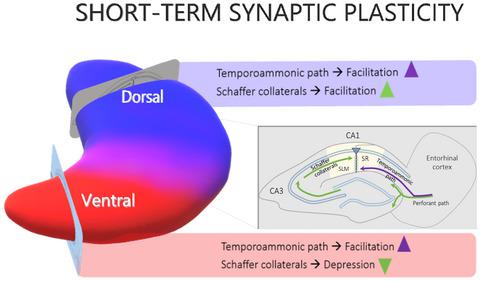Our official English website, www.x-mol.net, welcomes your
feedback! (Note: you will need to create a separate account there.)
Frequency‐dependent layer‐specific differences in short‐term synaptic plasticity in the dorsal and ventral CA1 hippocampal field
SYNAPSE ( IF 1.6 ) Pub Date : 2021-03-09 , DOI: 10.1002/syn.22199 Andriana Koutsoumpa 1 , Costas Papatheodoropoulos 1
SYNAPSE ( IF 1.6 ) Pub Date : 2021-03-09 , DOI: 10.1002/syn.22199 Andriana Koutsoumpa 1 , Costas Papatheodoropoulos 1
Affiliation

|
Information from the entorhinal cortex arrives to the hippocampal CA1 microcircuit directly through the temporoammonic path (TA) that terminates in the stratum lacunosum‐moleculare (SLM), and indirectly through Schaffer collateral pathway (SC) that terminates in the stratum radiatum (SR). By virtue of this input convergence, CA1 circuitry may act to compare and integrate incoming cortical information. Although a remarkable dorsal‐ventral difference in short‐term plasticity (STP) has been recently described at SC‐CA1 synapses, the corresponding properties at TA‐CA1 synapses have not been examined. Here, we report that stimulation of TA in the dorsal hippocampus produces significant facilitation of all conditioned responses evoked by 1–30 Hz, peaking at 20–30 Hz, and significant depression of steady‐state responses to 50–100 Hz. Dorsal SC‐CA1 synapses display a similar pattern of responses, yet, facilitation peaked at 10 Hz and depression (at 75–100 Hz) is weaker. Strikingly, stimulation of TA in the ventral hippocampus produces facilitation of steady‐state responses to 1–30 Hz and highly contrasts with the depression of SC‐CA1 synapses. Steady‐state responses to 40–100 Hz in the ventral hippocampus depress in both layers similarly. High‐frequency TA input (40–100 Hz) to the dorsal hippocampus depresses more in proximal than in distal SLM, while low‐frequency (1–3 Hz) TA input to the ventral hippocampus facilitates more in distal than in proximal SLM. The present evidence suggests that direct and indirect entorhinal cortical inputs across the septotemporal extent of hippocampal CA1 field display frequency selectivity both in the radial and transverse axes, and that a rapid information processing may take place through direct ventral hippocampal CA1‐EC circuit interactions independently of trisynaptic circuit.
中文翻译:

背侧和腹侧 CA1 海马区短期突触可塑性的频率依赖性层特异性差异
来自内嗅皮层的信息直接通过终止于腔隙分子层 (SLM) 的时间氨通路 (TA) 到达海马 CA1 微电路,并间接通过终止于辐射层 (SR) 的 Schaffer 侧支通路 (SC) 到达海马 CA1 微电路。凭借这种输入收敛,CA1 电路可以比较和整合传入的皮层信息。尽管最近在 SC-CA1 突触中描述了显着的背腹侧短期可塑性 (STP) 差异,但尚未检查 TA-CA1 突触的相应特性。在这里,我们报告刺激背侧海马中的 TA 会显着促进 1-30 Hz 诱发的所有条件反应,在 20-30 Hz 达到峰值,并显着抑制 50-100 Hz 的稳态反应。背侧 SC-CA1 突触显示出类似的反应模式,然而,促进在 10 Hz 达到峰值,而抑制(在 75-100 Hz)较弱。引人注目的是,刺激腹侧海马中的 TA 会促进对 1-30 Hz 的稳态反应,并与 SC-CA1 突触的抑制形成鲜明对比。腹侧海马对 40-100 Hz 的稳态反应在两层中同样下降。背侧海马的高频 TA 输入(40-100 Hz)在近端比远端 SLM 抑制更多,而到腹侧海马的低频(1-3 Hz)TA 输入在远端比近端 SLM 更容易。目前的证据表明,直接和间接的内嗅皮质输入跨越海马 CA1 区域的中隔范围在径向和横轴上显示频率选择性,
更新日期:2021-05-07
中文翻译:

背侧和腹侧 CA1 海马区短期突触可塑性的频率依赖性层特异性差异
来自内嗅皮层的信息直接通过终止于腔隙分子层 (SLM) 的时间氨通路 (TA) 到达海马 CA1 微电路,并间接通过终止于辐射层 (SR) 的 Schaffer 侧支通路 (SC) 到达海马 CA1 微电路。凭借这种输入收敛,CA1 电路可以比较和整合传入的皮层信息。尽管最近在 SC-CA1 突触中描述了显着的背腹侧短期可塑性 (STP) 差异,但尚未检查 TA-CA1 突触的相应特性。在这里,我们报告刺激背侧海马中的 TA 会显着促进 1-30 Hz 诱发的所有条件反应,在 20-30 Hz 达到峰值,并显着抑制 50-100 Hz 的稳态反应。背侧 SC-CA1 突触显示出类似的反应模式,然而,促进在 10 Hz 达到峰值,而抑制(在 75-100 Hz)较弱。引人注目的是,刺激腹侧海马中的 TA 会促进对 1-30 Hz 的稳态反应,并与 SC-CA1 突触的抑制形成鲜明对比。腹侧海马对 40-100 Hz 的稳态反应在两层中同样下降。背侧海马的高频 TA 输入(40-100 Hz)在近端比远端 SLM 抑制更多,而到腹侧海马的低频(1-3 Hz)TA 输入在远端比近端 SLM 更容易。目前的证据表明,直接和间接的内嗅皮质输入跨越海马 CA1 区域的中隔范围在径向和横轴上显示频率选择性,











































 京公网安备 11010802027423号
京公网安备 11010802027423号